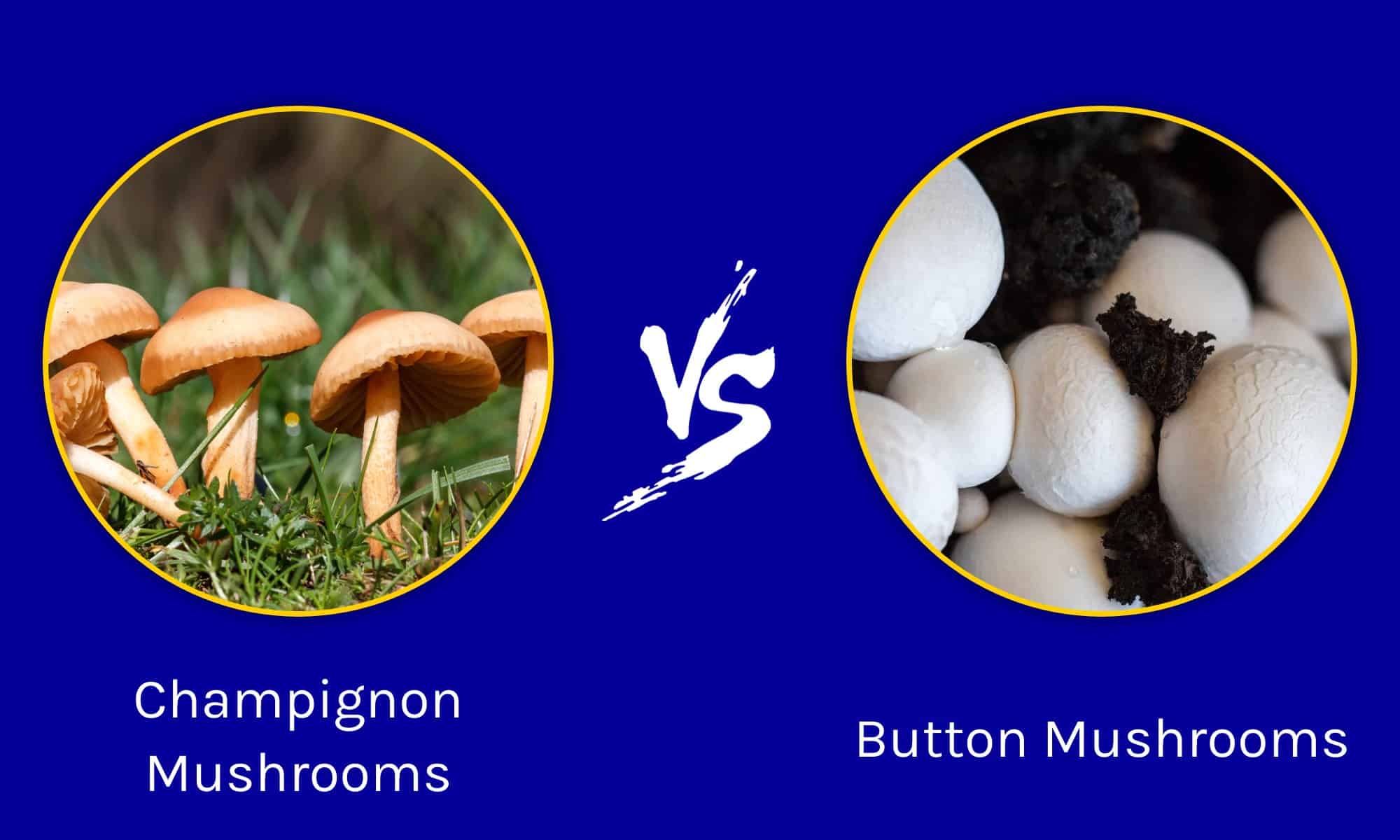Key Points
There are so many different mushrooms out there, and it can be challenging to tell them all apart. This is complicated by the fact that many mushroom species go by numerous different common names depending on where in the world you are or even how mature the mushroom is. You may have heard about both champignon mushrooms and button mushrooms. Are these two different mushrooms? If so, how can you tell them apart? What are the histories and uses for each?
This article will help you learn more about champignon mushrooms and button mushrooms and give you the knowledge you need to identify each. Let’s dive in together and learn about these two mushrooms now!
Comparing Champignon Mushrooms and Button Mushrooms
| Champignon Mushrooms | Button Mushrooms | |
|---|---|---|
| Scientific Name | “Champignon mushrooms” can refer to the species Agaricus bisporus or generally refer to any mushroom regardless of species. However, it can also refer to Marasmius oreades. | Agaricus bisporus |
| Genus | Marasmius | Agaricus |
| Family | Marasmiaceae | Agaricaceae |
| Division | Basidiomycota | Basidiomycota |
| Kingdom | Fungi | Fungi |
| Common Name | Fairy ring mushroom, fairy ring champignon, resurrection mushroom | Button mushroom, white button mushroom, white mushroom |
| Origin | The name “champignon” is French. The mushroom species Marasmius oreades is native to Europe and North America. | The name “button mushroom” is English, with the first known use of the name in 1708. The mushroom species Agaricus bisporus is cultivated in Asia, Europe, and North America. |
| Description of Fungus | Fairy ring champignon mushrooms grow in circles or rings, which inspired the name. Their caps can vary in color, from being white to tan or slightly red, and typically grow to be half an inch to 2 inches across. The gills are spread out and off-white or cream in color. The stems are straight and tough in texture. The caps are somewhat bell-shaped with a bump in the center. The mushrooms are smooth and have a sweet taste. The intensity of the flavor increases when dried. | When harvested at its earliest stage of maturity, mushrooms in the species Agaricus bisporus are called “button mushrooms.” Button mushrooms are white, mild in flavor, and small (between half an inch and 3 inches across). They have brown gills and white stems. |
| Harvesting Period | Fairy ring champignon mushrooms are harvested around the same period as button mushrooms are, after seven to 14 days of growing. | Button mushrooms may be harvested after seven to 14 days of growing (after the mycelium initially sprouts). |
Description of Champignon Mushrooms vs. Button Mushrooms

When you hear a recipe or chef reference “champignon” or “button” mushrooms, they are referring to
Agaricus bisporuswhen it is harvested at the youngest stage of maturity.
©BGSmith/Shutterstock.com
As you can read above, the name “champignon mushroom” and the name “button mushroom” can sometimes describe the same species! When that is the case, both terms typically refer to Agaricus bisporus. However, while “button mushroom” nearly always refers to Agaricus bisporus, “champignon” is a French word also used as the generic name for “mushroom.”
This means that at times, the word “champignon” may refer to other species aside from Agaricus bisporus. Over time, in English, the word “champignon” became associated with the species Marasmius oreades. Marasmius oreades is also known as the “fairy ring champignon.”
When you hear a recipe or chef reference “champignon” or “button” mushrooms, they are referring to Agaricus bisporus when it is harvested at the youngest stage of maturity. If they mention “fairy ring champignon,” they are most likely referring to Marasmius oreades.
Description of Fairy Ring Champignons
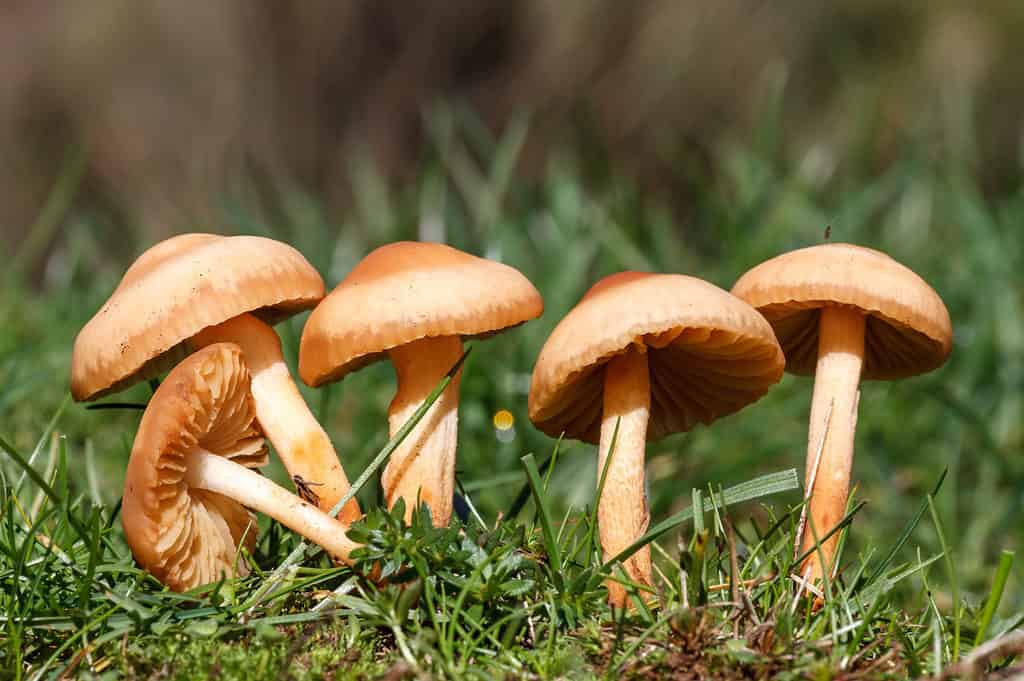
is not poisonous and neither is
Marasmius oreades.
©LFRabanedo/Shutterstock.com
Mushrooms that go by the name of “fairy ring champignon” are the species Marasmius oreades. Marasmius oreades is an edible fungus species in the Marasmiaceae family.
Fairy ring champignons gained their name for growing in arcs or rings. These rings can be as large as 15 feet in diameter! Their caps can come in a range of colors, from white to off-white beige to tan or slightly red. The caps grow in a bell shape with a distinctive hump in the middle. The gills underneath the cap are broad and spaced out. The stalk grows straight and in a cream-to-pale beige color, with a tough, dry texture. The caps of fairy ring champignons typically reach between half an inch and 2 inches in diameter.
While fairy circle champignons are also an edible mushroom, they are sometimes confused with several other mushroom species – some of which are poisonous! You may even see references to “poisonous champignon.” No need to worry! Agaricus bisporus is not poisonous and neither is Marasmius oreades. However, in France or French-speaking places, the “champignon” may be used to refer to other mushroom species, including those that are not edible.
Description of Button Mushrooms
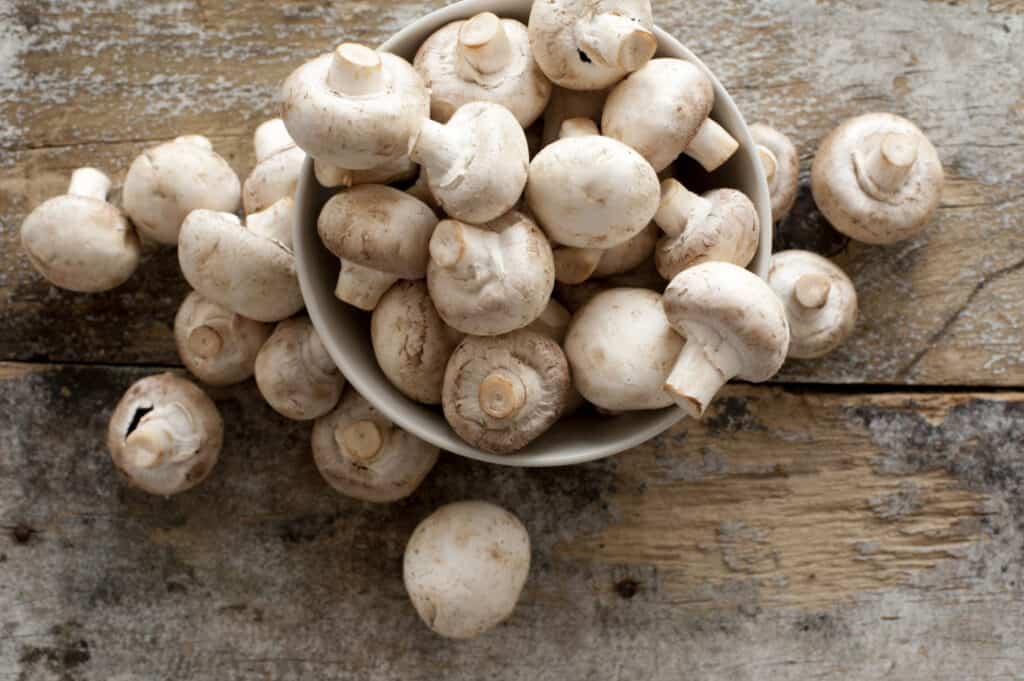
When you find either the item known as a “champignon” or “button” mushroom at a farmers’ market or grocery store, you are typically encountering the most immature form of the fungus
Agaricus bisporus.©Stephen Gibson/Shutterstock.com
Agaricus bisporus is also an edible fungus, but this one is a member of the Agaricaceae family. Agaricus bisporus is one of the most commonly-cultivated and popular mushrooms to consume in the world. When it is harvested at its youngest stage of maturity, it is referred to as a “button” mushroom. However, it also goes by many different names: white mushrooms, white button mushrooms, and others.
As the Agaricus bisporus mushroom matures, it is also harvested to be eaten. However, at that point, it goes by different names. When it is harvested at a later stage and beginning to darken into brown though not yet fully mature, the mushroom is known as a “baby bella,” “brown mushroom,” “crimini mushroom,” or “chestnut mushroom.” As it grows to full maturity, it is called a “portobello mushroom.”
When you find either the item known as a “champignon” or “button” mushroom at a farmers’ market or grocery store, you are typically encountering the most immature form of the fungus Agaricus bisporus. Button mushrooms are harvested when the mushroom is only between 1 and 3 inches across. At this point, it is tender and white. It also still has a mild flavor when eaten raw or cooked. As it gets older, the flavor will become stronger. However, at the button stage, it is still tiny. Button mushrooms are often harvested when only half an inch across and about the size of a fingernail!
Comparing Fairy Circle Champignons and Button Mushrooms
Fairy ring champignons and button mushrooms have some similarities, such as size, color, and a few other characteristics. However, they also have some different qualities when it comes to appearance, taste, history, and the etymology of their names.
Let’s learn more about the appearance, taste, and uses of both of these mushroom species. From there, we will discuss the etymology of these two names and how that history relates to culture and cuisine.
Champignon vs. Button Mushrooms: Appearance

has a few poisonous lookalikes.
©Melinda Nagy/Shutterstock.com
Appearance of Fairy Ring Champignons
Fairy ring champignon mushrooms are small, white to beige or slightly red-tinged tan, and typically grow caps that reach between half an inch and 2 inches across and are in a bell shape. Underneath the caps, the gills are off-white, spaced out, and can be either attached or free. The cap grows up from a straight, creamy-colored, or beige stem.
Beware! You can eat fairy ring champignons. Yet if you find them in the wild, proceed with caution. Marasmius oreades has a few poisonous lookalikes. Novices may mistake poisonous Clitocybe and Inocybe species, such as the Clitocybe dealbata, with the edible Marasmius oreades. However, there are some differences you can look out for to tell apart Marasmius oreades from its poisonous copycats. Clitocybe dealbata tends to be more of a gray-pink color and has gills that run down the stalk. Inocybe mushrooms usually have gills that are gray-brown in color.
Appearance of Button Mushrooms
As described earlier, the fungus known as a “button” mushroom goes by many other names. You may find it called a “white mushroom,” “common white mushroom,” or “white button mushroom.” Many of these names refer to the mushroom’s coloring, which ranges from pale white to light tan. However, you may find “white button mushrooms” that are more of a brown color. The name “button” also references the small, round appearance of the mushroom cap.
Button mushrooms can be somewhat similar in size to the fairy circle champignons. Cultivators often harvest these mushrooms when they are very tiny (half an inch across) or as large as 3 inches across. They have rounded caps that are smooth, firm, and rounded. The caps curve toward the bottom, hiding light brown gills, and sit atop short, white stems. However, they do not always grow in a circle or arc, so they miss out on that distinctive growing pattern of the fairy ring champignon species.
Champignon vs. Button Mushrooms: Growing Conditions
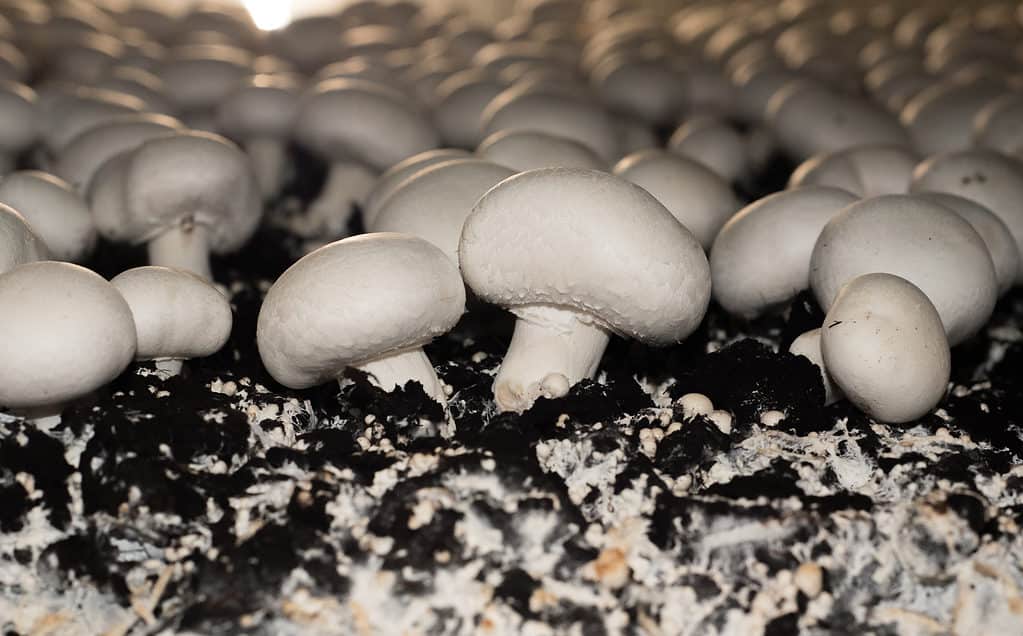
People began cultivating button mushrooms for human consumption hundreds of years ago.
©ArliftAtoz2205/Shutterstock.com
Marasmius oreades, the species of fairy ring champignons, grow in Europe and North America. They grow naturally in fields, grassy areas, or lawns. They often grow in circles or arcs, which can grow in size from year to year as the mycelium underground spreads. Approximately 50 species create these kinds of rings in the lawn.
Agaricus bisporus, the species of the button mushroom, grow in a range of climates and conditions. People cultivate this species across Asia, Europe, and North America. Though it grows naturally in moist, grassy areas with fertile soil, it also grows indoors under specific conditions.
People began cultivating button mushrooms for human consumption hundreds of years ago. Today, cultivators still grow them inside and outdoors in conditions of warmth and nitrogen-rich manure or compost. This mimics the natural, fertilizer-rich soil of the fields where mushrooms grow naturally and allows the spores to develop.
Champignon vs. Button Mushrooms: Taste
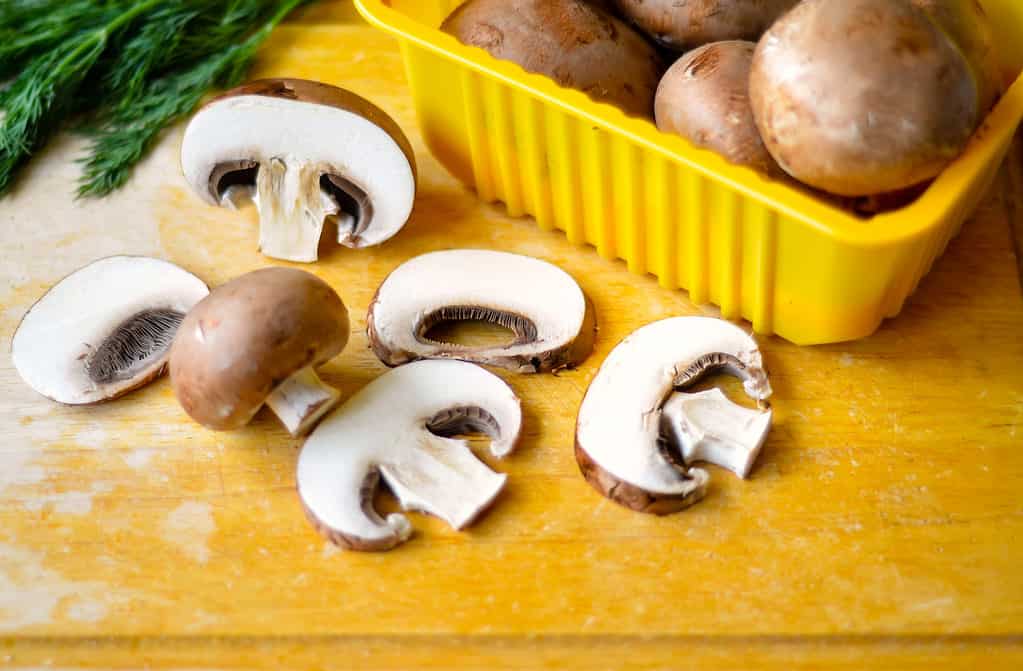
Fairy ring champignons and button mushrooms have some similarities, such as size, color, and a few other characteristics.
©Tatiana.Sidorova/Shutterstock.com
Fairy ring champignons are edible and typically eaten as an ingredient in soups and stews. Because they contain a sugar called tehalose, they have a sweet flavor and often form the basis of sauces, such as that in a pasta dish. You may notice that fairy ring champignons have a striking, intense taste that you can smell even before eating the mushroom. This taste is even stronger after the mushrooms are dried. This makes them a strong flavor enhancer for broth or stew.
When harvested at their earliest maturity, button mushrooms have a mild flavor and slightly chewy, though still tender, texture. They are slightly earthy but do not have as much of a distinctive flavor as other mushroom species or even the taste of Agaricus bisporus when harvested at greater maturity. Unlike fairy ring champignons, people eat all parts of the button mushroom: cap, stem, and gills. Unlike fairy ring champignons, which have a distinctive taste, button mushrooms have such a mild flavor that they are used in combination with other mushrooms that bring a stronger mushroomy taste.
Champignon vs. Button Mushrooms: Uses
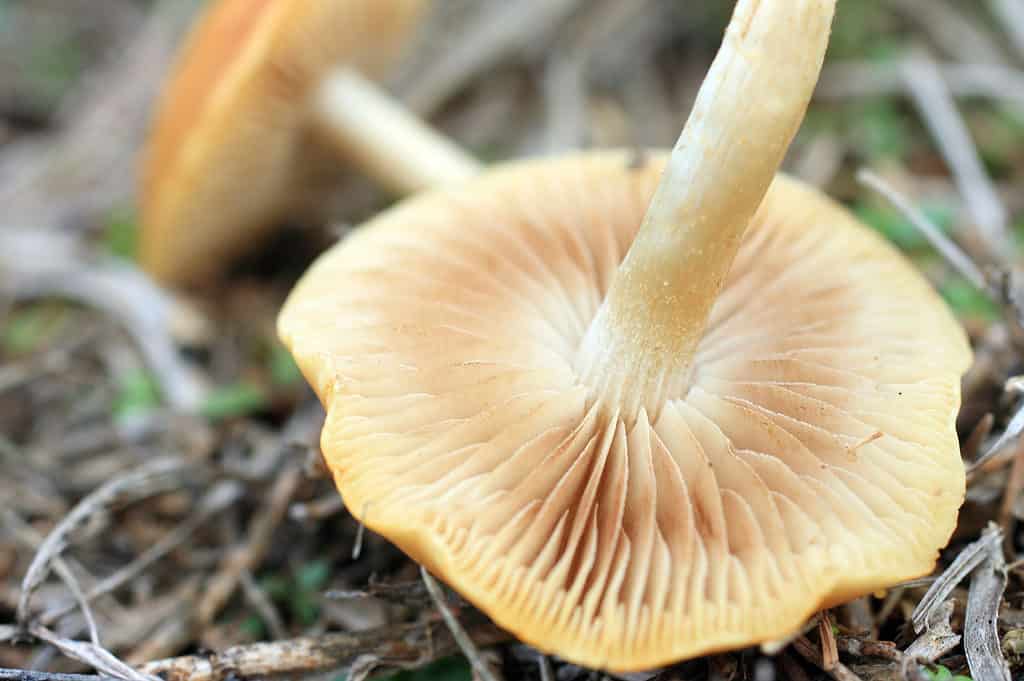
Chefs often add both fairy ring champignon and button mushrooms to salads, soups, noodle or pasta dishes, stir fry, and even dishes like pizza!
©Fortish/Shutterstock.com
Chefs often add both fairy ring champignon and button mushrooms to salads, soups, noodle or pasta dishes, stir fry, and even dishes like pizza! Typically, those who eat fairy ring champignons trim and discard stems, eating only the caps. In contrast, all parts of the button mushroom are pleasant to eat. People often eat button mushrooms whole. However, they may be sliced into smaller pieces. They can also be eaten either raw or cooked.
Typically, you do not need to wash your mushrooms, and many chefs advise against washing them with water, because the mushrooms may soak up the water and become soggy. Instead, you can brush or rub the dirt off of the mushrooms using a towel. If you don’t like the idea of not washing the mushrooms, you may rinse them briefly and then pat them dry. Store the mushrooms in the refrigerator with a damp cloth covering them. Others recommend placing the dry, uncut mushrooms in a brown paper bag. However, it is typically recommended that you avoid keeping the mushrooms in a sealed plastic bag. This can make them go bad faster and become slimy and inedible.
Champignon vs. Button Mushrooms: History and Etymology
Though mushrooms have been consumed by humans for thousands of years, we have early cultivation of Agaricus bisporus recorded in Europe from the 1500s onward. Larger-scale production of mushrooms grew in the 1600s, and eating mushrooms has continued to grow in popularity.
Agaricus bisporus is cultivated all over the world, in both outdoor and indoor growing environments, especially in western Europe, North America, and Southeast Asia. Consuming Agaricus bisporus in its youngest form, when it is referred to as a champignon or button mushroom, is very popular. A large amount of mushrooms are harvested at this early stage of maturity.
But What Does Champignon Even Mean?
The word “champignon” in English is a noun meaning “a mushroom.” In French, the word comes directly from a linguistic history This word comes from the French word champignon, which came from Old French champegnuel. Champegnuel is derived from Vulgar Latin campaniolus, which refers to “that which grows in a field.” It is from Late Latin campaneus, which means “pertaining to the fields” and comes from the word campania, meaning “level country.” This etymology reflects the history of mushrooms growing naturally in damp, grassy fields where there would be ample cow or horse manure, in which the mushrooms could thrive.
When used by a French speaker, the word “champignon” can mean mushrooms generally. Since introduced into English vocabulary in the 18th century, the word came to mean only edible mushroom species.
While at times it is used to refer to Agaricus bisporus, or “button mushrooms,” it also gained a new meaning in English. In that context, the word “champignon” became associated with the species Marasmius oreades, also known as the “fairy ring champignon” or “fairy ring mushroom,” a species that grows natively in North America and Europe.
In Summary
This article describes the two mushroom species: Marasmius oreades, commonly known as the “fairy ring champignon,” and Agaricus bisporus, commonly known as the “button mushroom” when harvested at its youngest stage of maturity. We also explored the unique histories and etymologies of these two words, which developed as two different languages’ names for the same thing. If you haven’t yet tried eating or cooking with mushrooms, why not try the button mushroom to start? Once you get good at identifying them, maybe try Marasmius oreades next. Including a champignon or button mushroom in your next recipe is an easy way to experiment with a delicious and nutritious, but mild-flavored mushroom!
Editor’s Note: While A-Z Animals does its best to ensure the accuracy of its content and photography, do not eat wild mushrooms without firsthand knowledge from a local mycologist or mushroom expert as many types of mushrooms look similar.
The information presented on or through the Website is made available solely for general informational purposes. We do not warrant the accuracy, completeness, or usefulness of this information. Any reliance you place on such information is strictly at your own risk. We disclaim all liability and responsibility arising from any reliance placed on such materials by you or any other visitor to the Website, or by anyone who may be informed of any of its contents. None of the statements or claims on the Website should be taken as medical advice, health advice, or as confirmation that a plant, fungus, or other item is safe for consumption or will provide any health benefits. Anyone considering the health benefits of particular plant, fungus, or other item should first consult with a doctor or other medical professional. The statements made within this Website have not been evaluated by the Food and Drug Administration. These statements are not intended to diagnose, treat, cure or prevent any disease.
Thank you for reading! Have some feedback for us? Contact the AZ Animals editorial team.

